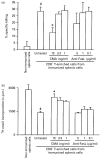Granule-dependent killing of Toxoplasma gondii by CD8+ T cells
- PMID: 11722643
- PMCID: PMC1783309
- DOI: 10.1046/j.1365-2567.2001.01319.x
Granule-dependent killing of Toxoplasma gondii by CD8+ T cells
Abstract
Immunization of mice with live bradyzoites of a low-virulent Beverley strain of Toxoplasma gondii has been shown to increase CD8+ T-cell mediated immunity against a highly virulent RH strain. We found that preimmunization with an RH homogenate further enhanced this immunity. Using this model, we investigated the mechanism of CD8+ T-cell mediated protection against T. gondii infection. Splenic cells from mice immunized with RH homogenate and live bradyzoites stimulated apoptosis of RH-infected J774A.1 macrophages in vitro, and at the same time, the immunization significantly suppressed the proliferation of parasites within macrophages, as assessed by measuring 3H-uracil uptake by the parasites. Splenic cells from the immunized mice produced larger amounts of interferon-gamma (IFN-gamma) than did naive splenic cells; however, the production of nitric oxide (NO) by RH-infected macrophages was not enhanced. The elimination of CD8+ T cells from splenic cells significantly reduced their inhibitory action on parasite proliferation as well as their cytotoxic activity against RH-infected macrophages, but it did not affect the production of IFN-gamma. Treatment of CD8+ T-enriched splenic cells from the immunized mice with concanamycin A, but not an anti-Fas ligand monoclonal antibody, significantly reduced their anti-proliferative and killing capabilities, suggesting that the CD8+ T cells induced by immunization with RH antigen and live bradyzoites of the Beverley strain may exert protection against T. gondii infection at least in part through granule-dependent cytotoxic activities.
Figures





Similar articles
-
CD8+ T cells from mice vaccinated against Toxoplasma gondii are cytotoxic for parasite-infected or antigen-pulsed host cells.J Immunol. 1991 Oct 1;147(7):2310-6. J Immunol. 1991. PMID: 1918963
-
IL-15 prolongs the duration of CD8+ T cell-mediated immunity in mice infected with a vaccine strain of Toxoplasma gondii.J Immunol. 1999 Oct 15;163(8):4503-9. J Immunol. 1999. PMID: 10510393
-
DNA immunization with eukaryotic initiation factor-2α of Toxoplasma gondii induces protective immunity against acute and chronic toxoplasmosis in mice.Vaccine. 2013 Dec 16;31(52):6225-31. doi: 10.1016/j.vaccine.2013.10.034. Epub 2013 Oct 31. Vaccine. 2013. PMID: 24183979
-
CD8+ T-cell interactions with Toxoplasma gondii: implications for processing of antigen for class-I-restricted recognition.Res Immunol. 1993 Jan;144(1):51-7. doi: 10.1016/s0923-2494(05)80099-9. Res Immunol. 1993. PMID: 8095730 Review.
-
The immune system utilizes two distinct effector mechanisms of T cells depending on two different life cycle stages of a single pathogen, Toxoplasma gondii, to control its cerebral infection.Parasitol Int. 2020 Jun;76:102030. doi: 10.1016/j.parint.2019.102030. Epub 2019 Nov 25. Parasitol Int. 2020. PMID: 31778800 Free PMC article. Review.
Cited by
-
DNA vaccination with a gene encoding Toxoplasma gondii Deoxyribose Phosphate Aldolase (TgDPA) induces partial protective immunity against lethal challenge in mice.Parasit Vectors. 2014 Sep 8;7:431. doi: 10.1186/1756-3305-7-431. Parasit Vectors. 2014. PMID: 25201636 Free PMC article.
-
Direct microbicidal activity of cytotoxic T-lymphocytes.J Biomed Biotechnol. 2010;2010:249482. doi: 10.1155/2010/249482. Epub 2010 Jun 23. J Biomed Biotechnol. 2010. PMID: 20617144 Free PMC article. Review.
-
Predominant role of interferon-γ in the host protective effect of CD8(+) T cells against Neospora caninum infection.Sci Rep. 2015 Oct 9;5:14913. doi: 10.1038/srep14913. Sci Rep. 2015. PMID: 26449650 Free PMC article.
-
Heligmosomoides bakeri and Toxoplasma gondii co-infection leads to increased mortality associated with changes in immune resistance in the lymphoid compartment and disease pathology.PLoS One. 2024 Jul 1;19(7):e0292408. doi: 10.1371/journal.pone.0292408. eCollection 2024. PLoS One. 2024. PMID: 38950025 Free PMC article.
-
A Deep Insight Into Regulatory T Cell Metabolism in Renal Disease: Facts and Perspectives.Front Immunol. 2022 Feb 17;13:826732. doi: 10.3389/fimmu.2022.826732. eCollection 2022. Front Immunol. 2022. PMID: 35251009 Free PMC article. Review.
References
-
- Scharton-Kersten TM, Wynn TA, Dnkers EY, Bala S, Grunvald E, Hieny S, Gazzinelli RT, Sher A. In the absence of endogenous IFN-γ, mice develop unimpaired IL-12 responses to Toxoplasma gondii while failing to control acute infection. J Immunol. 1996;157:4045–54. - PubMed
-
- Gazzinelli R, Xu Y, Hieny S, Cheever A, Sher A. Simultaneous depletion of CD4+ and CD8+ T lymphocytes is required to reactivated chronic infection with Toxoplasma gondii. J Immunol. 1992;149:175–80. - PubMed
-
- Gazzinelli RT, Hakim FT, Hieny S, Shearer GM, Sher A. Synergistic role of CD4+ and CD8+ T lymphocytes in IFN-γ production and protective immunity induced by and attenuates Toxoplasma gondii vaccine. J Immunol. 1991;146:286–92. - PubMed
-
- Suzuki Y, Remington JS. The effect of anti-IFN-γ antibody on the protective effect of LYT-2+ immune T cells against toxoplasmosis in mice. J Immunol. 1990;144:1954–6. - PubMed
-
- Suzuki Y, Orellana MA, Schreiber RD, Remington JS. Interferon-γ: the major mediator of resistance against toxoplasmosis in mice. Science. 1988;240:516–8. - PubMed
Publication types
MeSH terms
Substances
Grants and funding
LinkOut - more resources
Full Text Sources
Research Materials
Miscellaneous

